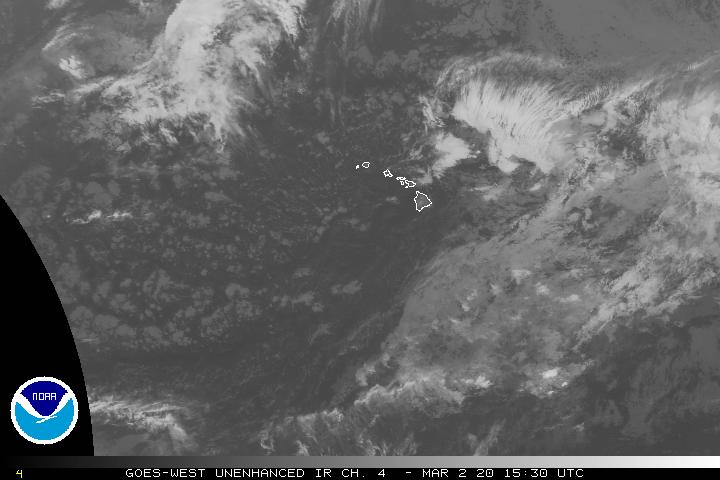Air Temperatures – The following high temperatures (F) were recorded across the state of Hawaii Sunday…along with the low temperatures Sunday:
77 – 68 Lihue, Kauai
81 – 73 Honolulu, Oahu
mm mm Molokai
80 – 70 Kahului AP, Maui
79 – 67 Kailua Kona
78 – 67 Hilo AP, Hawaii
Here are the latest 24-hour precipitation totals (inches) for each of the islands Sunday evening:
0.89 Mount Waialeale, Kauai
0.28 Moanalua RG, Oahu
0.21 Molokai
0.02 Lanai
0.00 Kahoolawe
1.16 Puu Kukui, Maui
0.64 Kawainui Stream, Big Island
The following numbers represent the strongest wind gusts (mph) Sunday evening:
22 Port Allen, Kauai
31 Oahu Forest NWR, Oahu
29 Molokai
32 Lanai
38 Kahoolawe
30 Maalaea Bay, Maui
38 Pali 2, Big Island
Hawaii’s Mountains – Here’s a link to the live webcam on the summit of our tallest mountain Mauna Kea (nearly 13,800 feet high) on the Big Island of Hawaii. Here’s the webcam for the Haleakala Crater on Maui. These webcams are available during the daylight hours here in the islands, and at night whenever there’s a big moon shining down. Also, at night you will be able to see the stars — and the sunrise and sunset too — depending upon weather conditions.
Aloha Paragraphs

High pressure north…deep storm low northwest

High cirrus and a cold front well north of the state

Clear to partly cloudy leeward…locally cloudy windward

A few showers locally – Looping image
~~~ Hawaii Weather Narrative ~~~
Small Craft Advisory…Maui County windward, Maalaea Bay, Pailolo and Alenuihaha Channels, and Big Island leeward and southeast waters
Broad Brush Overview: Strong trade winds will continue locally into Monday, before a weak cold front approaching the islands from the northwest, brings lighter winds Tuesday into Wednesday. Trade showers will fall along windward areas. Look for an increase in clouds and showers starting Tuesday night ahead of the front, especially over Kauai and Oahu. This front will dissipate by later Wednesday, with moderate trade winds over the western side of the state Wednesday night. A new area of high pressure is expected to build in east of the islands later in the week, producing lighter winds and drier conditions Thursday through Friday.
Details: The trades will weaken Tuesday as a new cold front approaches from the northwest. As the front moves closer Tuesday, the weaker trade winds over the smaller islands may allow local sea breezes to form during the afternoon. An upper level trough is also forecast to move toward the state from the northwest Tuesday. This will cause the upper level ridge to weaken and shift eastward,…allowing some destabilization of the atmosphere. This could lead to an increase in showers Tuesday afternoon when clouds and showers develop over leeward and interior sections of the smaller islands.
The upper trough will support the front pushing toward Kauai Tuesday night and early Wednesday. This front should be near Kauai Wednesday, where it will continue to weaken. Regardless of the movement of this front, increased moisture ahead of and along the front will likely enhance the shower coverage over the western islands. Therefore, widespread showers may affect windward areas with some showers spreading leeward. A surface trough also appears to form east of the front, which may bring additional showers to the Big Island and parts of Maui County too.
Looking Further Ahead: The latest forecast indicates the trade winds will fill in briefly over the western side of the state Wednesday night as the front dissipates. This will be followed by lighter winds winds Thursday through Friday. Also, look for drier conditions toward the end of the work week, with mainly light showers over windward areas during nights and mornings. There’s also a chance of daytime sea breezes developing by Friday, with some interior clouds and showers in the afternoon. By next weekend, another weak cold front approaches the islands from the northwest…and may cause a slight increase in showers for Kauai and Oahu.
Here’s a wind profile of the Pacific Ocean – Closer view of the islands / Here’s the vog forecast animation / Here’s the latest weather map
Marine environment details: The west-northwest swell continues to be large, although should drop below advisory levels for Kauai County tonight as the swell gradually diminishes…and may extend into Monday for the Big Island.
A powerful, hurricane force low tracking rapidly northeast over the northwest Pacific, is generating another a northwest swell, that will begin to arrive Tuesday. This swell will persist for several days, with advisory level surf expected along most north and west facing shores Tuesday and Wednesday, and surf may approach warning levels when the expected peak of the swell occurs Thursday. Another powerful low emerging off the coast of Japan on Monday will produce another large northwest swell…that is expected next weekend.
A surface high pressure cell to the distant north of the islands will maintain locally strong (near gale force in the Alenuihaha channel) trade winds into Tuesday. A Small Craft Advisory (SCA) in effect for many marine zones…with an extension into Tuesday likely for the windier zones.
A decrease in wind speeds is expected later Tuesday as a cold front approaches the area from the northwest. As the front stalls and weakens near Kauai and Oahu Tuesday night and Wednesday, a new high building northwest of the islands will bring what is now expected to be a temporary increase in trade winds. Although winds will likely be below SCA criteria for much of next week, the northwest swells will lead to combined seas exceeding the SCA criteria in many zones from Wednesday onward.
World-wide Tropical Cyclone activity
>>> Here’s the Sunday PDC Weather Wall Presentation, covering Tropical Cyclone 03S (Ava) and Tropical Cyclone 04S (Irving) both in the South Indian Ocean
![]()
>>> Atlantic Ocean:
>>> Caribbean Sea:
>>> Gulf of Mexico:
Here’s a satellite image of the Caribbean Sea…and the Gulf of Mexico
Here’s the link to the National Hurricane Center (NHC)
>>> Eastern Pacific:
Here’s a wide satellite image that covers the entire area between Mexico, out through the central Pacific…to the International Dateline.
Here’s the link to the National Hurricane Center (NHC)
>>> Central Pacific:
Here’s a link to the Central Pacific Hurricane Center (CPHC)
>>> Northwest Pacific Ocean: No active tropical cyclones
>>> North and South Indian Oceans / Arabian Sea:
Tropical Cyclone 03S (Ava)
JTWC textual forecast warning
JTWC graphical track map
NOAA satellite image
Tropical Cyclone 04S (Irving)
JTWC textual forecast warning
JTWC graphical track map
NOAA satellite image
Here’s a link to the Joint Typhoon Warning Center (JTWC)
Interesting: The Ocean Is Suffocating, and It’s Our Fault – Ocean “dead zones” — regions of the sea where oxygen is severely or entirely depleted and most forms of life can’t survive — are becoming more numerous, and scientists warn that they will continue to increase unless we curb the factors driving global climate change, which is fueling this alarming shift in ocean chemistry.
Even outside these near-lifeless ocean regions, rising global temperatures and influxes of nutrient pollution are throttling oxygen levels in the open ocean and in coastal areas, threatening communities of sea life around the world.
This sobering view of the “suffocating” ocean was described in a new study, in the journal Science. The study is the first to present such a comprehensive evaluation of ocean oxygen depletion and its causes. And less oxygen in the ocean doesn’t just spell trouble for marine plants and animals — it could carry serious repercussions for life on land as well, the researchers cautioned.
While water molecules contain oxygen atoms, liquid water must also contain dissolved oxygen in order for fish and other organisms to breathe. Oxygen-deprived dead zones were first identified in estuaries — bodies of water where rivers flow into the sea — in the mid-19th century, and their oxygen depletion was linked to the presence of urban sewage in the water, lead study author Denise Breitburg, a marine ecologist with the Smithsonian Environmental Research Center.
Since then, growth of industrial and agricultural activity has disrupted the ocean’s chemical balance, with regions in many areas worldwide becoming infused with pollutants and nutrients that starved the water of oxygen. Meanwhile, rising global temperatures hamper oxygen’s solubility in water and restrict its distribution into the deeper ocean. At the same time, some forms of marine life have grown increasingly stressed due to warmer and more acidic oceans, which increases their oxygen requirements.
A global investigation
A team of scientists from the Global Ocean Oxygen Network, a group formed by the United Nation’s Intergovernmental Oceanographic Commission in 2016, conducted the investigation, and they found that the toll on Earth’s oceans has been significant.
Over the past 50 years, the ocean suffered a loss of about 85 billion tons of oxygen, affecting an accumulated area approximately the size of the European Union. Globally, the amount of zero-oxygen ocean water has quadrupled, while the area occupied by low-oxygen zones has increased by 10 times, the researchers discovered. In coastal areas and seas that are semi-enclosed, once low-oxygen conditions are established, they can persist for thousands of years, according to the study.
“If we lost 4.5 million square kilometers of productive area on land, everyone would be appalled,” Breitburg said in a statement. “But what happens beneath the surface of the ocean is out of sight, and easy to either not notice or ignore.”
As oxygen levels in water drop, the behavior and growth of fish and other ocean organisms is affected — a lack of oxygen can make them more susceptible to disease, or make it more difficult to reproduce. In extreme cases, they can suffocate. While certain types of microorganisms thrive under low oxygen conditions, most larger forms of sea life either die or abandon oxygen-starved waters, invading nearby ecosystems where they may upset the balance of life, disrupt food webs or increase their vulnerability to predators, the study authors explained.
Restoring oxygen
In some cases, evidence shows that the damage can be reversed, and areas where nutrients and sewage had sucked oxygen from the water may yet recover once the flow of contaminants is removed.
For example, parts of the Thames Estuary in London and the Delaware River Estuary — both of which endured long periods with no oxygen and no fish — “are now much improved and host vibrant fish communities,” Breitburg said.
And in Massachusetts’ Chesapeake Bay — long known for dead zones that seasonally cover about 30 percent of its area — nitrogen pollution levels have decreased by 24 percent, a result of improved farming practices and sewage management, and better air quality under regulations such as the Clean Air Act, according to the study.
However, when it comes to oxygen loss in the open ocean, “we’re in uncharted territory,” Breitburg said. “We don’t know how long it will take for the ocean to respond.”
Addressing this global issue will require worldwide cooperation and initiatives to mitigate fossil fuel emissions and curb nutrient pollution. Establishing more protected areas in the ocean and supporting policies that preserve threatened and vulnerable marine life will also help struggling ecosystems recover, the study authors reported.
“Slowing and ultimately halting the decline of oxygen in the open ocean, and oxygen decline in coastal waters that is due to climate change, will take a global effort, but it needs to be done — not only to improve oxygen in the ocean, but to avoid the worst of the devastation that global warming can cause,” Breitburg said.













 Email Glenn James:
Email Glenn James:
tim Says:
Hi Glenn, My friend is a crab fisherman in AK and he said last year when they had the warmer water the crabs were bigger than normal. He said the crabs were huge. Just curious because back in the dino times 165 million years ago everything was big because the earth was hot and there were lots of large plants and trees producing oxygen. If the earth warms up there would be more oxygen, do you think we are having a decline in the ocean as some scientist’s say we are headed in to a mini ice age due to the suns cycle. Thanks, Tim
~~~ Hi Tim, good to hear from you. You make a good point, and ask a good question. As for a mini ice age, it doesn’t seem like that’s happening to me.
Happy New Year…
Aloha, Glenn